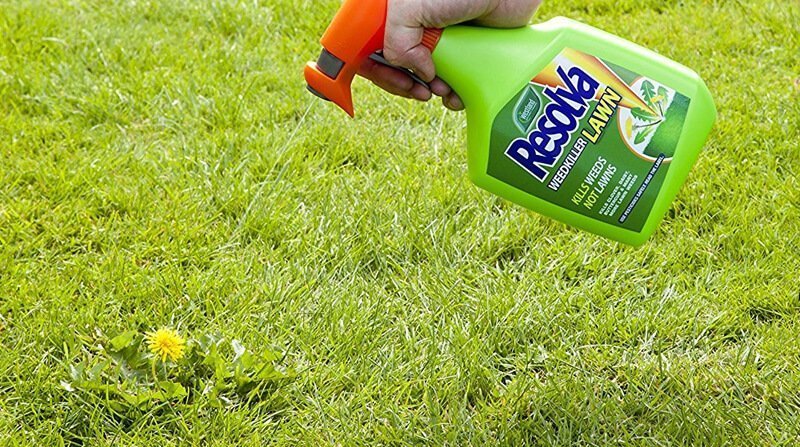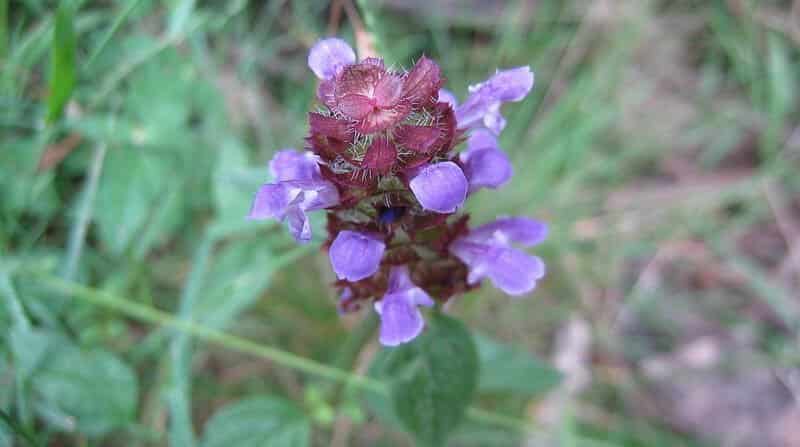Self Heal or Prunella Vulgaris goes by a few names, including;
- Heal-all
- Carpenters Weed
- Wild Sage, or
- Prunella Weed
Whatever you like to call it, it’s a common lawn weed in the UK and because it’s so aggressive, it can cause major problems if left to its own devices.
That said, with the right approach you can get rid of it and prevent it from growing back and in this article, I’ll show you how.
Self Heal in a Nutshell
Knowing a little bit about Heal-all will help you in your battle against it.
Appearance

The leaves are bourn in pairs are oval in shape with pointed tips. They can be smooth or slightly hairy depending on how mature the plant is.
Stems are square and are also hairy but smooth as the weed ages.
Flowers bloom between June and October. They’re dark violet to purple in colour, around half an inch in height with two, stemless leaves underneath.
A Perennial Weed
Self Heal is a stubborn perennial weed which means it’ll stay there and keep producing flowers each year if it’s not dealt with.
It grows close to the ground and spreads by producing rhyzomes (underground runners) which root at intervals forming large, dense patches that smother any grass underneath it.
Preferred Habitat
It’ll happily grow in all lawns and conditions but it really likes nutrient-deficient soils. You might see it alongside other weeds like Yarrow weed, and Creeping Thistles.
How to Remove Self Heal From a Lawn
It’s best to remove Self Heal as soon as you see it in your lawn before it has a chance to establish itself and produce seeds.
Here’s how;
Remove it by Hand
If there are only a few plants in your lawn you can try and remove them by hand or with a hand fork.
It produces shallow roots so raking the area to lift them first is a good idea, then take care of any remaining roots with your hand fork or trowel.
Completely removing Self Heal without the use of a weedkiller might take a few attempts.
Kill it with a Spot Spray Weedkiller

Killing Self Heal with a selective weedkiller is another option if you only have a few plants. The chances of eliminating it the first time are much higher because the herbicide kills the plant at the root.
Make sure you use a selective weed killer. They are designed to kill weeds but be gentle on the grass.
- Small handheld spray for small areas
- Kills weeds in your lawn without damaging the grass
Spray the whole lawn with a Weed Killer Concentrate
The presence of Self Heal in your lawn is often a sign of nutrient-deficient soil. So chances are, other weeds that do well in this environment (Daises, Black Medic and Dandelions) will inhabit it too.
In this case, spot spraying it useless so spray the whole lawn with a weed killer concentrate.
Products like Weedol Lawn Weedkiller Concentrate are designed to be diluted with water and sprayed onto the lawn with a knapsack sprayer or watering can.
Just make sure you dilute the herbicide as per the manufacturer’s instructions. If you dilute it too much it won’t be strong enough to kill the weeds. However, if you make it too strong you run the risk of killing the grass too.
- Apply through a sprayer or watering can
- Easy to use and does not damage the lawn
Read: How to Pick the Best Lawn Weed Killer
How to Prevent Self Heal From Inhabiting Your Lawn
As you now know, Self Heal is often a sign or symptom of nutrient-deficient soil. So you need to make changes to the soil to make it fertile.
But there are other lawn care practices that you keep on top of if you want to keep your lawn free of weeds.
Here’s what you need to do;
Remove Excess Lawn Thatch With a Scarifier

Thatch is a layer of organic material that lies on the surface of the soil, in amongst the grass. It’s consists of both dead and living grassroots, shoots and runners, as well as other stuff like old grass clippings.
Some lawn thatch (quarter on an inch) is a good thing because it protects the crown of the grass plant when you use the lawn.
However, too much thatch acts as a barrier which prevents water, air and nutrients from penetrating the soil. This starves the roots of what they need to produce food and grow. As such so you end up with a lawn of sparse, patchy, unhealthy grass.
The perfect environment for weeds like Self Heal to invade.
Scarification uses a machine or hand tool to tear excess thatch up and out of the lawn. This enables water, air and nutrients to penetrate the soil, stimulating grass growth and root development.
Scarifying your lawn is a harsh treatment so it’s important to do it in the autumn when conditions for growth are good. This, combined with a good recovery program will have your lawn looking better than it ever has.
Relieve Soil Compaction by Aerating

Soil compaction occurs in on in heavily used lawns. Children playing on the grass or regularly used routes across the lawn (around washing lines for example) squeeze the soil particles together, pushing out air and water.
This starves the grass’s roots of what it needs to produce food and grow. Also, grassroots don’t establish well in hard, compacted soil.
The result is unhealthy, weak, often patchy grass which is the perfect environment for Self Heal, weed and moss infestations.
To relieve this compaction you need to aerate the lawn. This can be done by spiking (usually in the spring and autumn with a fork or spiking shoes) or hollow tining (in autumn every 2-3 years with a hollow tie aerator).
Spiking makes holes in the lawn so air, water and nutrients can penetrate the soil which stimulates grass growth.
Hollow tining removes cores of turf from the lawn. This means that nutrients can penetrate the soil but it also creates space for compacted soil to relax and spread into, allowing the grasses roots to grow and establish properly.
Read: How, Why and When to Aerate Your Lawn
Keep Your Lawn Fertile

Grass needs three vital nutrients to grow and produce food. They are;
- Nitrogen
- Potassium
- Phosphate
Without these nutrients, grass will struggle to grow and your lawn will be open to moss and weed invasions. So it’s important to get these nutrients back into the soil.
You can do it by applying a good quality, slow-release fertiliser after scarifying and aerating and scarifying. There’s no point in doing it before because it won’t be able to penetrate compacted soil or lawn thatch.
After that, apply a fertiliser at least once a year to keep the nutrients in the soil topped up. The grass will thank you for it!
Read: Everything You Need to Know About Fertilising Your Lawn
Also Read: Which is the Best Lawn Feed? Full Buyers Guide and My Top Recommendations
Cut the Grass on a Regular Basis

Last but definitely not least…
…To prevent weeds like Self Heal from having the room to germinate and grow, you MUST mow the lawn regularly.
Cutting the grass on a regular basis is the most important part of lawn care. But it’s also the most overlooked and millions of people all over the UK do it wrong.
Healthy grass has to grow and without being cut regularly it’ll just grow upwards. When you cut the grass regularly it can’t grow upwards and is forced to grow sideways, producing new runners that sprout new grass leaves.
When this happens your lawn becomes thick with grass. A lawn with lots of grass makes it difficult for weed seeds to find their way into the soil to germinate, and even if they do, the grass outcompetes the new weed and makes it difficult for the weed to establish and grow.
If you only cut the grass every few weeks when the lawn looks untidy, the grass doesn’t need to grow sideways, it’ll keep growing upwards. This means your lawn will never be as dense as it could (or should) be, making it easier for weeds to get to the soil, germinate and grow.
Also, when you cut the grass, you’re likely to cut it too short.
Grass leaves are made up of 95% water with the other 5% being stored food, Nitrogen and other nutrients.
When you cut it, you essentially take away its water and food supply. And grass leaves are like solar panels. They’re used to trap sunlight to produce food via photosynthesis. So not only do you rob it of its water and food supply but you also take away its ability to produce more food.
This shocks, often kills the grass, turning it brown and spiky which opens the lawn up to disease, weed and moss infestations.
So cut the grass at least every 10 days between April and October. In May and September when conditions for growth are particularly good, do it every 7 days.
Read: Mowing the Lawn: How to Do it Like a Pro
Also Read: Choosing the Right Type of Lawn Mower
In Conclusion
Self Heal is an aggressive weed if left to spread.
The good news is that it’s not that difficult to kill and remove. A good lawn weedkiller will do the trick.
Preventing weeds from inhabiting your lawn isn’t difficult either. All it takes is a bit of knowledge and the commitment to apply it.
In only a matter of weeks, you can transform your lawn from a weed-infested mess to a lush, green carpet thick with grass.
So have a go, there’s no need to get a lawn care professional in to do it unless you really can’t be bothered.
I’d love to see your lawn transformations so take before and after pictures and send them in and I’ll share them with the community.
Also, if you have any questions, please do leave a comment below.




Very helpful, Tim. Succinct and easy to read by non gardener techno’s such as myself.
Thanks.
Peter.
Excellent information and better than I have seen anywhere else. A real eye opener to me who has Self Heal rampant on my lawn.
Brilliant information and advice. Thanks so much. 👍🏽